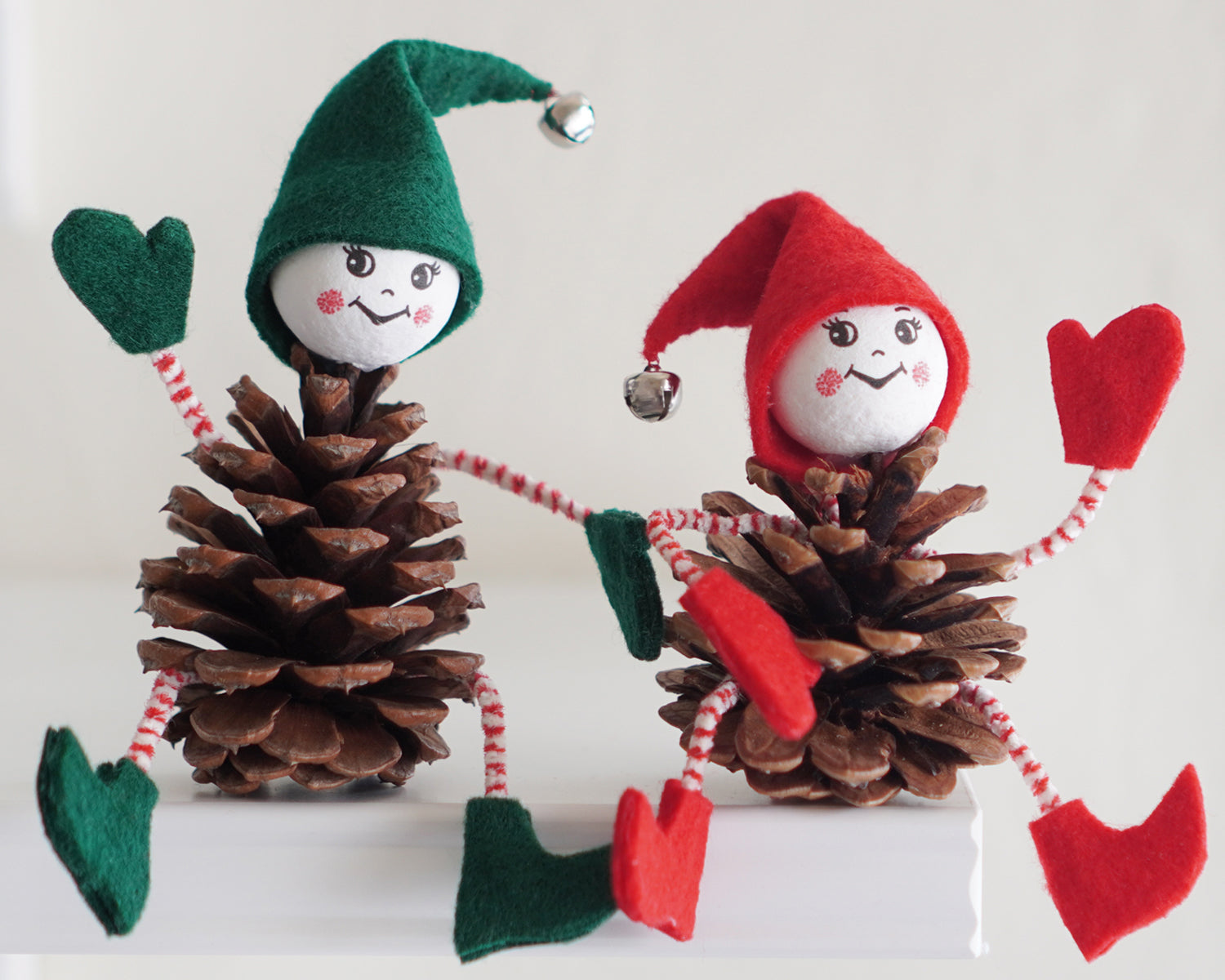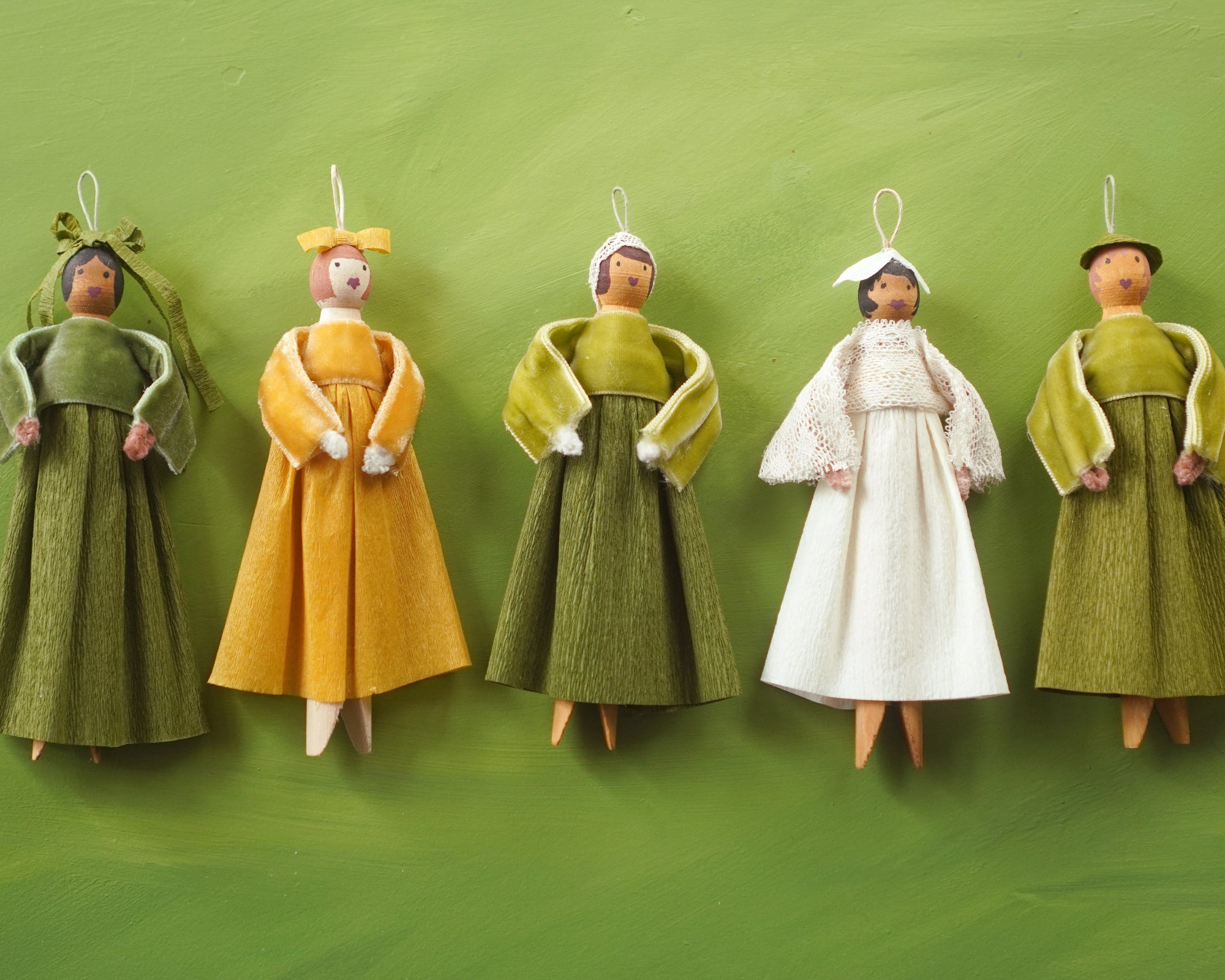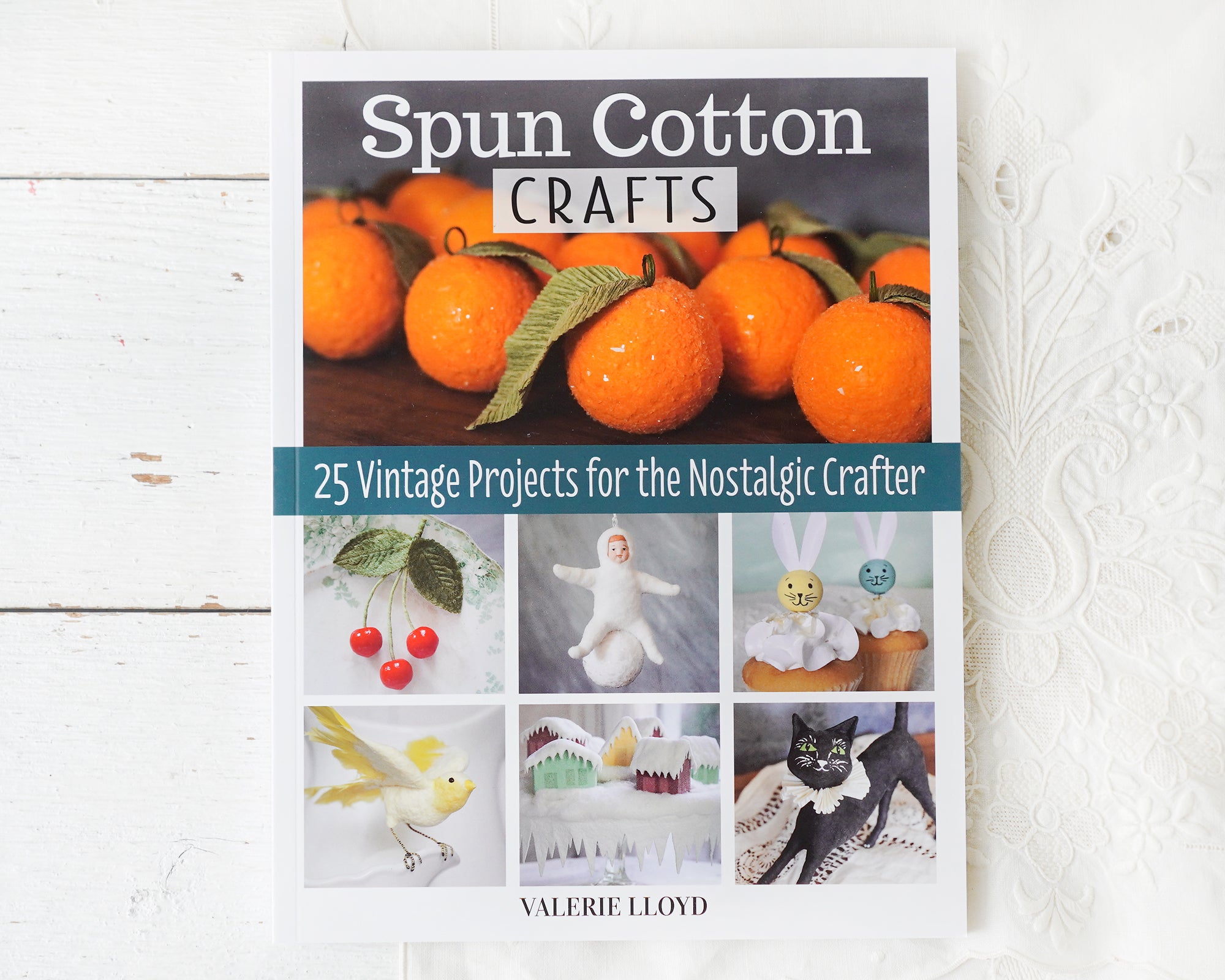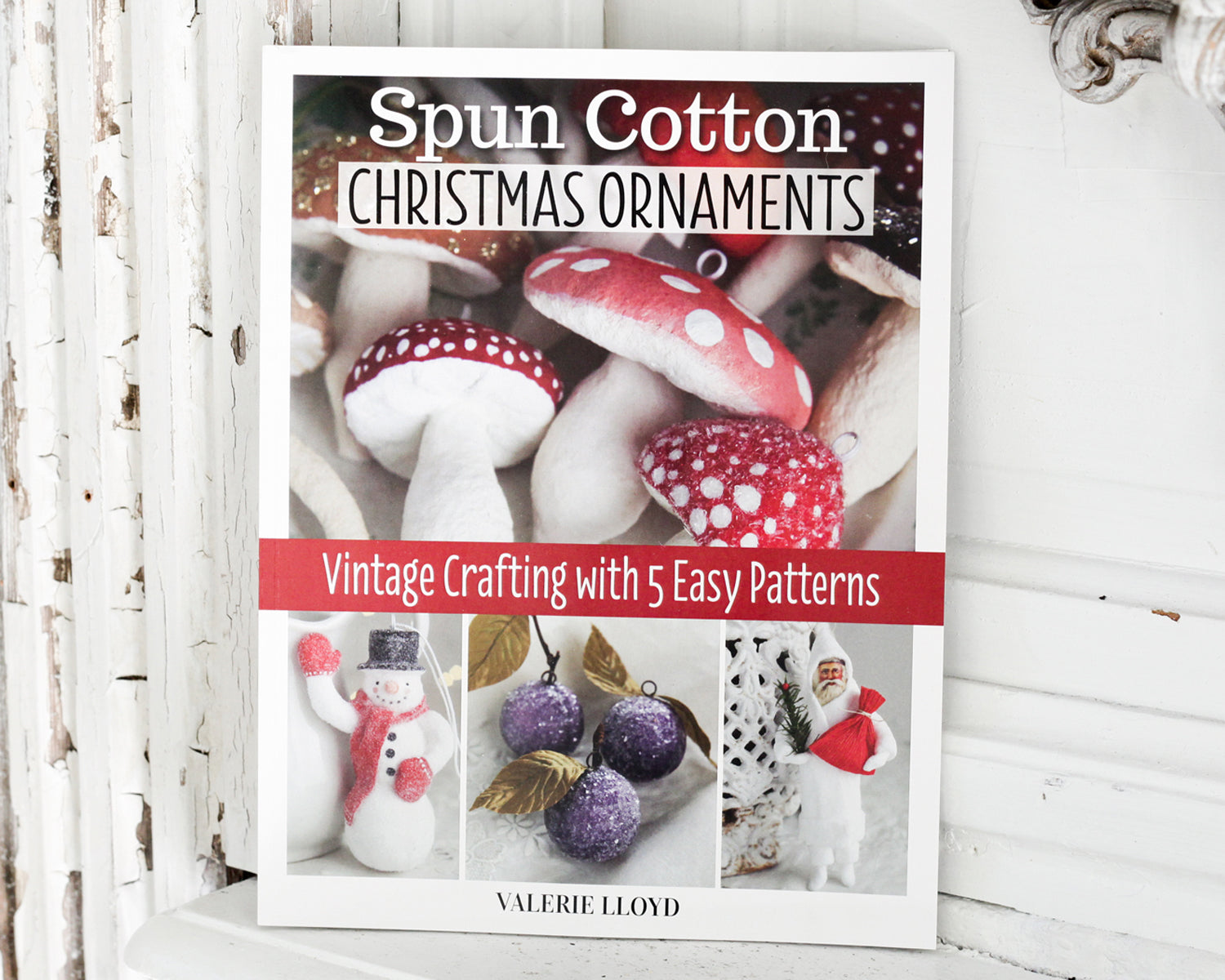Spun Cotton How-To: Making Vintage Style Champagne Bottle Ornaments

Today I'm making some entirely hand-built spun cotton champagne bottle ornaments inspired by some antique factory-made versions from the 1920s. Because the silhouette is fairly simple, I am building the pieces on an aluminum knitting needle. This allows me to use the needle as a handle while I work. When I'm done building the shape, the needle slides right out, leaving a convenient hole for a hanging loop at the top. I am using cotton coil for this project, but you can easily substitute medical cotton roll torn into strips which has a similar texture. Cotton roving will also work, though it is less forgiving, so forming the angular parts of the bottle and cork will be a little more challenging to apply.
If this is your first time hand-building spun cotton, plan on making 2 or 3 pieces simultaneously so you can practice and experiment. This medium, similar to paper mache, requires a lot of drying time which allows for a bit of play in between.
I have designed a page of tiny champagne labels in various sizes for you to download and print for free. I printed mine on a sheet of calligraphy parchment in an ecru color. Thinner papers are best, as the label needs to bend to fit the contour of the bottle.
As Amazon Associates we earn from qualifying purchases.
Click HERE to download your free printable labels. Remember to set your printer to 100% (do not scale.)
Supplies:
- Printable champagne labels (click to download)
- Calligraphy parchment paper
- Cotton coil
- Aluminum knitting needle
- Cotton sewing thread
- Starch medium made from cornstarch and water (see below for mixing instructions)
- Soft, flat paintbrushes
- Glue stick
- Imitation gold leaf
- Tissue paper or crepe paper in accent color of your choice
- Clear glass glitter
- Glove
- White Glue (Elmer's Glue-All or similar PVA)
- Scissors
- 30 gauge fine wire
- Cotton embroidery cord or other string for hanging loops
Part 1: Building the Shape
Step 1:
Tear off a length of cotton coil about a foot long, and then split it into thinner strands, about 3/4 inch thick. If using medical cotton, split the sheet into thin layers, and then tear into strips. Lay the end of the strip over the knitting needle about 2 1/2 inches from the point, and roll over the end of the cotton to hold it in place. Turn the needle with one hand, and use the other to wrap the cotton evenly all the way to the end of the needle. Tug slightly on the cotton as you work to keep the wrappings tight and consistent. Direct the cotton strip back on itself to wrap back to the starting place. If the strand breaks at any time, just wrap over the loose end and continue. When you finish a strip, smooth the end down against the shape, compress the cotton with your fingers, and add the next strip. Continue adding cotton strips, gradually building the shape of the bottle: wide at the end of the needle, and slimmer at the neck of the bottle. Adding a thinner strand of cotton around the lowest point will form the cork.
Part 2: Thread Wrapping
Step 2:
Wrappings of cotton thread will make it dense and sturdy, refining the shape. Keeping the thread on the spool, wrap the end of the thread around the bottle to secure it. Then start wrapping around the entire shape, not pulling the thread tight, but wrapping it consistently top to bottom. Use the thread to pull in lumpy areas, focusing on the overall silhouette of the bottle. Add tufts of cotton to low points, and wrap over them to further define the shape. When you have created a symmetrical piece, snip the thread, and feed the end of the thread under one of the wrappings to secure it.
Part 3: Base Layer Application
Step 3:
In order to begin applying cotton in layers, you need to prepare a batch of starch medium. In a bowl, mix 1 Tbsp. cornstarch with 1 Tbsp. cold water to create a slurry. In a pot on the stovetop, bring 1 cup of water to a boil, then reduce to simmer. Add the starch slurry a spoonful at a time to the water, until all is dissolved. Simmer for 2 minutes, stirring continuously. Let cool.
Step 4:
Use a soft, flat paintbrush to brush starch on the thread wrapped bottle. You will find that you can use the brush to further flatten out any lumps between thread wrappings to make a smoother surface. Once the whole bottle has been moistened with starch, tear small, flat pieces of cotton and apply them to the bottle. Smooth the cotton down with your fingers, and then brush with starch to press them onto the surface. Seek out a smooth application by pressing out any air bubbles. Cotton pieces can be overlapped slightly, and layered to fill out the shape and cover all the thread wrappings. Once fully covered, use your fingernail or a small tool to impress a line where the cork meets the bottle. You can also tie a small piece of thread around it as it dries to create that line. Set the needle up in a jar, and allow the piece to dry in a warm spot overnight. You can expect the base layer to shrink up a little or have some puckering as it dries, but it will dry fairly firm, and this will make a nice base for the final layer of cotton.
Part 4: Final Layer
Step 5: With the piece fully dried, brush a light coat of starch on the surface, and begin adding more pieces of cotton. Study the cotton, and choose pieces with an even texture and few lumps. Smooth each one against the surface with your fingers before starching. Add cotton until you are satisfied with both the shape and the surface texture, and then let dry fully before painting.
Part 5: Painting & Embellishing
Step 6:
Thin craft paint slightly with some starch medium so that it sinks into the surface, leaving few brush strokes. Paint the bottle with 1-2 coats, and let dry.
Step 7:
Print out the Champagne labels on thin paper, and cut out the label of your choice. Bend the label so that it will fit the contour of the bottle. Lay it face down on a piece of scrap paper, and apply glue stick right up to the edges. Apply the label to the bottle and hold in place for about 20 seconds or until it holds without lifting.
Step 8:
Cover the entire top of the bottle with glue stick, and use a brush to ensure a thorough, even layer of glue has been applied. Gold leaf will stick to any area with glue. Lay a sheet of gold leaf over the bottle, and tap it onto the glue. Use a brush to press it into the crevices. If there are any gaps, just brush on a little more glue and use scraps of leaf to patch the bare spots. Let dry. Once the glue is dry, use a soft brush to remove the loose bits of leaf.
Step 9:
Cut thin ribbons of tissue paper or crepe paper to embellish the neck of the bottle. Crepe paper can be stretched slightly to conform to the shape of the bottle. Apply with glue.
Step 10:
Insert the knitting needle or a smooth bamboo skewer to use as a handle for glittering. Thin some clear-drying glue slightly with water, and brush over the surface of the bottle, avoiding the label and embellishments. Brush away any drips so that it is an even coating, and then with a gloved hand, sprinkle lightly with clear glass glitter. Prop up in a jar until dry, and then remove from the knitting needle or skewer.
Step 11:
Bend a short length of thin wire in half to create a small hanging loop. Apply glue to the open hole at the top, insert the ends of the loop, and let dry. Add a loop of cord or string.


Products Featured in this Tutorial:
Want more on spun cotton? Check out my book: Spun Cotton Christmas Ornaments!
PIN ME:









